Linux System Administration
 Suraj
SurajTable of contents
- Linux file editor(vi):
- Difference Between vi and vim editor
- “sed” Command:
- User Account Management:
- Enable Password Aging
- Switch users and sudo access
- Monitor Users:
- Talking to Users
- Linux Account Authentication
- Difference between these:
- System Utility Commands
- Processes and Jobs
- Process/Service Commands
- Additional Cron Jobs
- Process management
- System Monitoring
- Log Monitoring
- System Maintenance Commands
- Changing the system Hostname
- Finding System Information
- System Architecture
- To check the Architecture
- Terminal Control Kyes
- Terminal Commands
- Recover Root Password
- SOS Report
- Environment Variables
- Special Permissions with setuid, setgid, and sticky bit
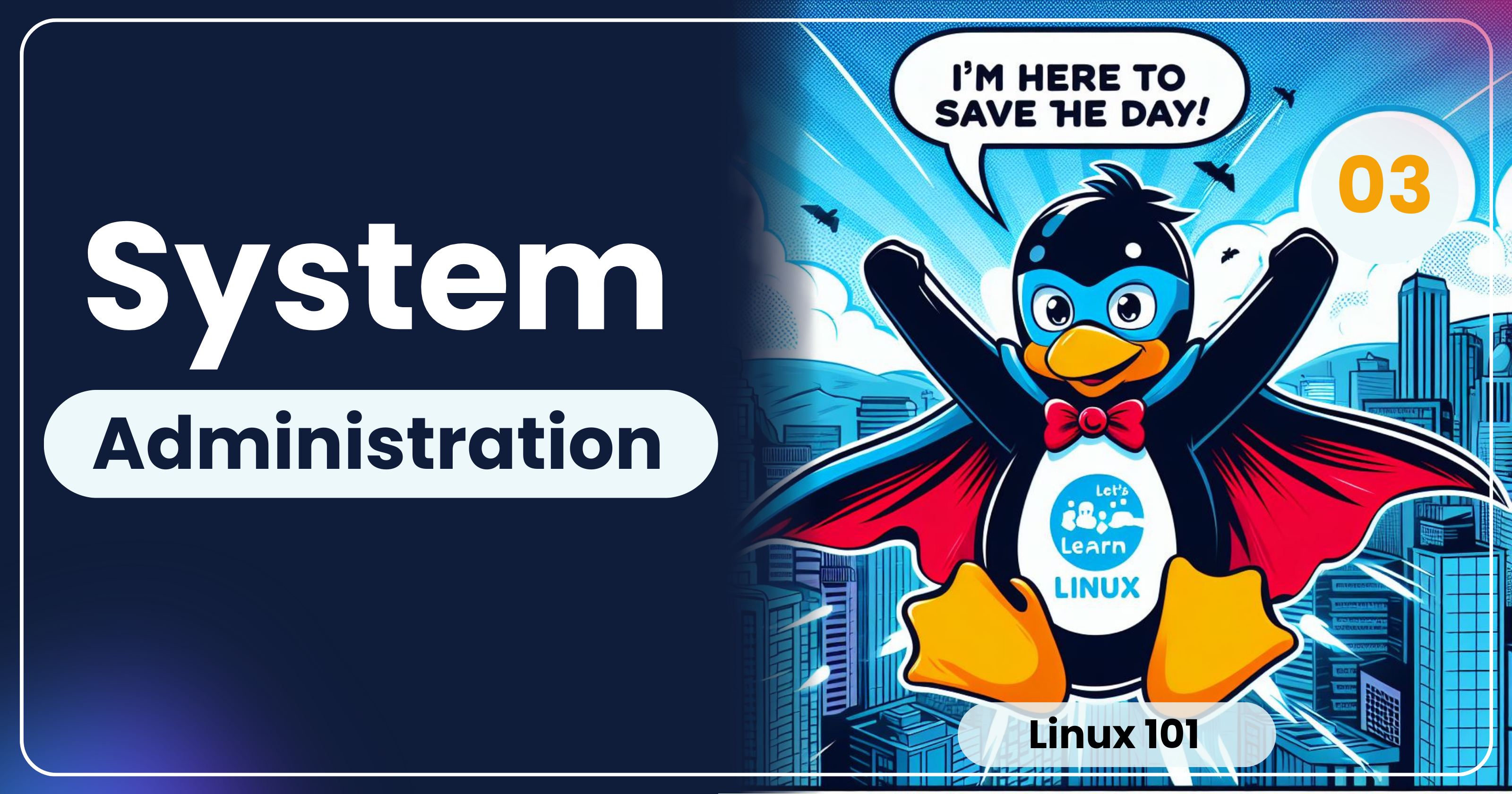
Linux file editor(vi):
A text editor is a program that enables you to create and manipulate data (text) in a Linux file
There are several standard text editors available on most Linux systems
vi - visual editor
ed - standard line editor
ex - extended line editor
emacs - a full-screen editor
pico - beginner’s editor
vim - advanced version of vi
Our editor = vi ( available in almost every Linux distribution)
vi supplies commands for:
inserting and deleting text
replacing text
moving around the file
finding and substituting strings
cutting and pasting text
Most common keys:
i- insertEsc- escape out of any moder- replaced- delete:q!- quit without saving:wq!- quit and save
Difference Between vi and vim editor
| Feature | Vi | Vim |
| Graphical Interface | Terminal-based | Includes a graphical user interface (GUI) |
| Extended Features | Basic functionality | Syntax highlighting, multiple undo/redo levels, language support |
| Visual Mode Improvements | Limited visual mode capabilities | Enhanced visual mode with block selection, visual line mode |
| Plugin System | N/A | Supports a wide range of plugins for extensibility |
| Backward Compatibility | Standard Vi commands and configs | Maintains backward compatibility with Vi |
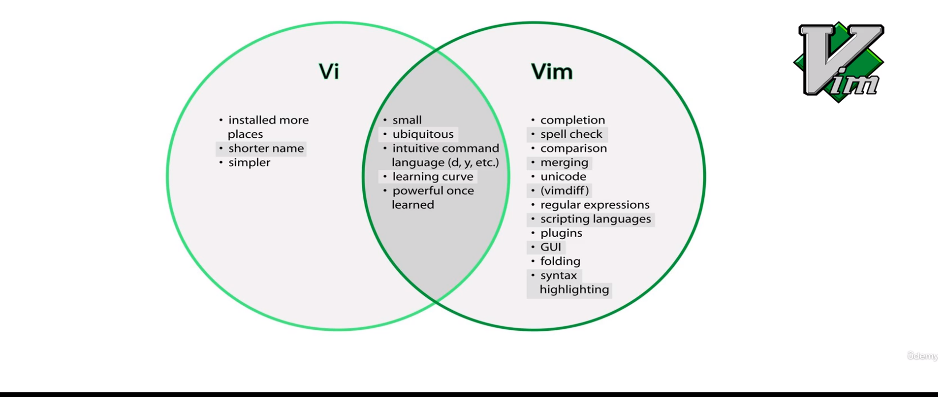
Websites to learn “vim” - interactive learning tools
“sed” Command:
Replace a string in a file with a newstring
Find and delete a line
Remove empty lines
Remove the first or n lines in a file
To replace tabs with spaces
Show defined lines from a file
Substitute within vi editor
If you want to change the name Kenny here with Lenny using sed command and “-i” used to insert this change permanently
sed -i 's/Kenny/lenny/g' surajkumar00
if you want to remove any word
sed 's/kumar//g' surajkumar00
If you want to delete all the lines that have the name suraj anyway it will be deleted. surajkumar00 here is the filename
sed '/suraj/d' suarjkumar00
If you have empty lines and want to get rid of those empty lines, $ here is nothing(empty)
sed -i '/^$/d' surajkumar00
If you want to remove the first line of your file
sed -i '1d' filename
If you want to remove the first two lines of your file
sed -i '1,2d' filename
If you want to remove the tab space in your file
sed -i 's/\\t/ /g' filename
if you want to add tab spaces
sed -i 's/ /\\t/g' filename
If you want to see files starting from specific lines
sed -n 12,18p filename
If you want to see the content of your files except lines 12 to 18
sed 12,18d filename
If you want to empty lines also in your content file
sed -i G filename
If you want to replace the name suraj with S but except line 8
sed '8!s/suraj/S/g' filename
Name changes while you are in the vi editor:
:%/suraj/mohit
this command is entered in the vi editor which changes the suraj with Mohit in all lines.
User Account Management:
Commands
useradd - adds new user
groupadd - adds a new group
userdel - delete a user
groupdel - delete a group
usermod :
- I wanted to add goupname to a different group as well,
we can do it this way:
usermod -G groupname username
Files
- /etc/passwd
cat /etc/passwd
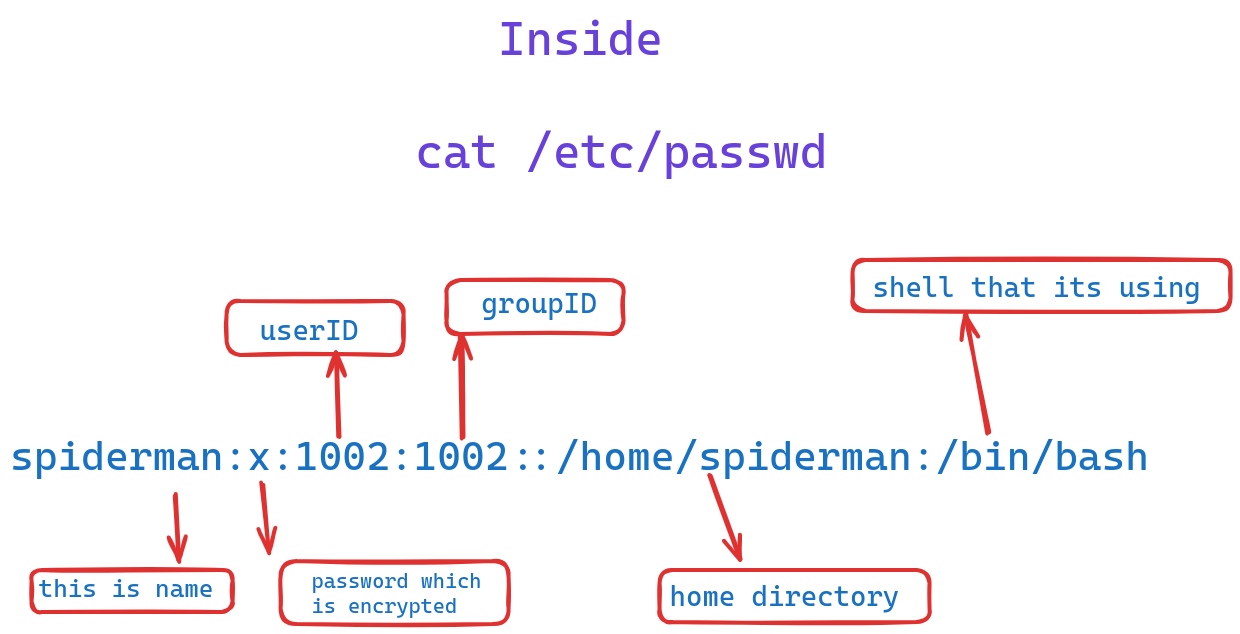
- /etc/group
cat /etc/group
it shows group name:passwd(x): groupID(1003)
- /etc/shadow : it is strictly for passwords for users we create
cat /etc/shadow
- if you do not set the password in /etc/shadow for any name you not see the encrypted password
Example:
useradd -g superheroes -s /bin/bash -c "user description" -m -d /home/spiderman spiderman
-g is for the group, -s to give the shell environment, c is for user description, -m -d to define the user's home directory and the user itself.

Enable Password Aging
The /etc/login.defs file = Configuration control definitions for the login package.
The chage command
It is specifically used to set the parameters around the password. It’s not used to make any changes to the user account itself.
The chage command -per user
- Example
chage [-m mindays] [-M maxdays] [-d lastday] [-I inactive] [-E expiredate] [-W warndays] user
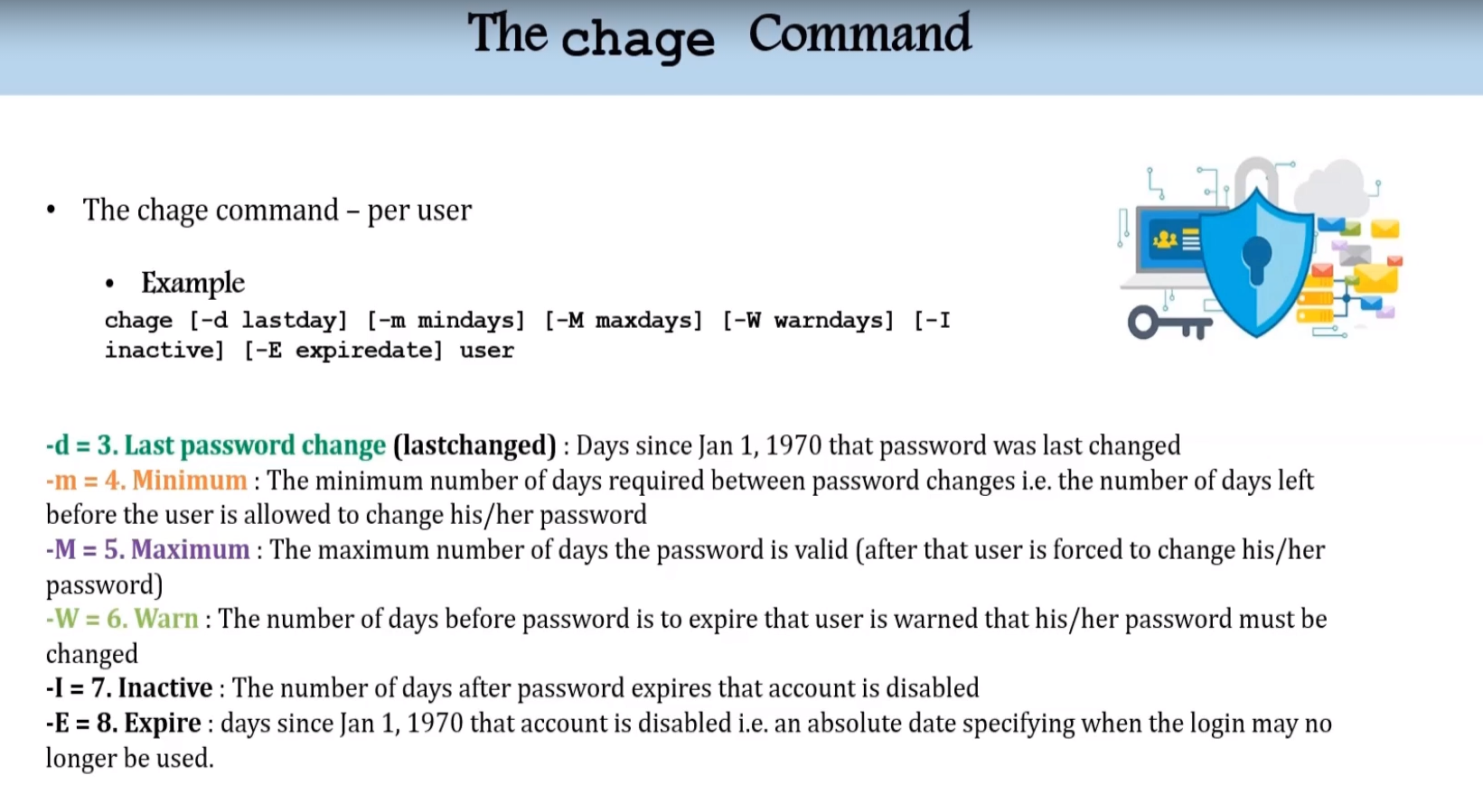
File = /etc/login.defs
PASS_MAX_DAYS 99999
PASS_MIN_DAYS 0
PASS_MIN_LEN 5
PASS_WARN_AGE 7

Switch users and sudo access
Commands
su - usernamesudo commandvisudo
used for:
usermod -aG wheel username
to verify
grep wheel /etc/group
used for:
sudo dmidecode
used for: tell you the size of the disk and all the information
sudo fdisk -l
File
/etc/sudoers: The/etc/sudoersfile is used to configure sudo access for users and groups in Unix-like operating systems.
Monitor Users:
Commands:
who: to see how many people are logged into our system
last: give all information about the user who logged in since the first day
last | awk '{print $1}' | sort | uniq
w: It works pretty much the same as who but it will give you a little more information than who.
finger: It is the command that is added to your system. so, it does not come with your distribution. you have to add it, it’s a very powerful program. you need to install that.
Become root and run the below command:
yum install finger -y
id: if you run theidcommand it will give you information about the current directory user and if you place another user after theidcommand it’ll give that user’s information.
id
id username
Talking to Users
Commands:
users: To check how many users are logged in
wall: to communicate with all users who are currently logged in
wall
// then write you message here and press Ctrl + D
- write
write username
//then write you message here
Linux Account Authentication
Types of accounts
Local accounts
Domain/Directory accounts
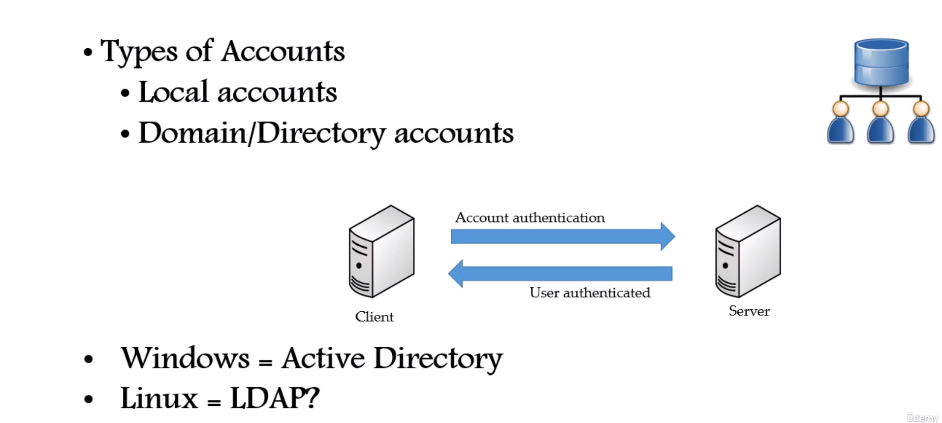
Difference between these:
| Technology | Description |
| Active Directory | Microsoft's proprietary directory service for centralized management of network resources and authentication. |
| LDAP | Protocol used for accessing and maintaining distributed directory information services over an IP network. |
| IDM | Identity Management is a broader term encompassing various technologies to manage user identities, access, and policies. A product by Red Hat. |
| WinBIND | Part of Samba facilitates the integration of Linux/UNIX systems with Windows domains by providing a bridge between the two. |
| OpenLDAP | An open-source implementation of LDAP, offering a free, open, and extensible directory service. |
System Utility Commands
Commands:
date: it shows you the date time and day and sets the date
uptime
uptime
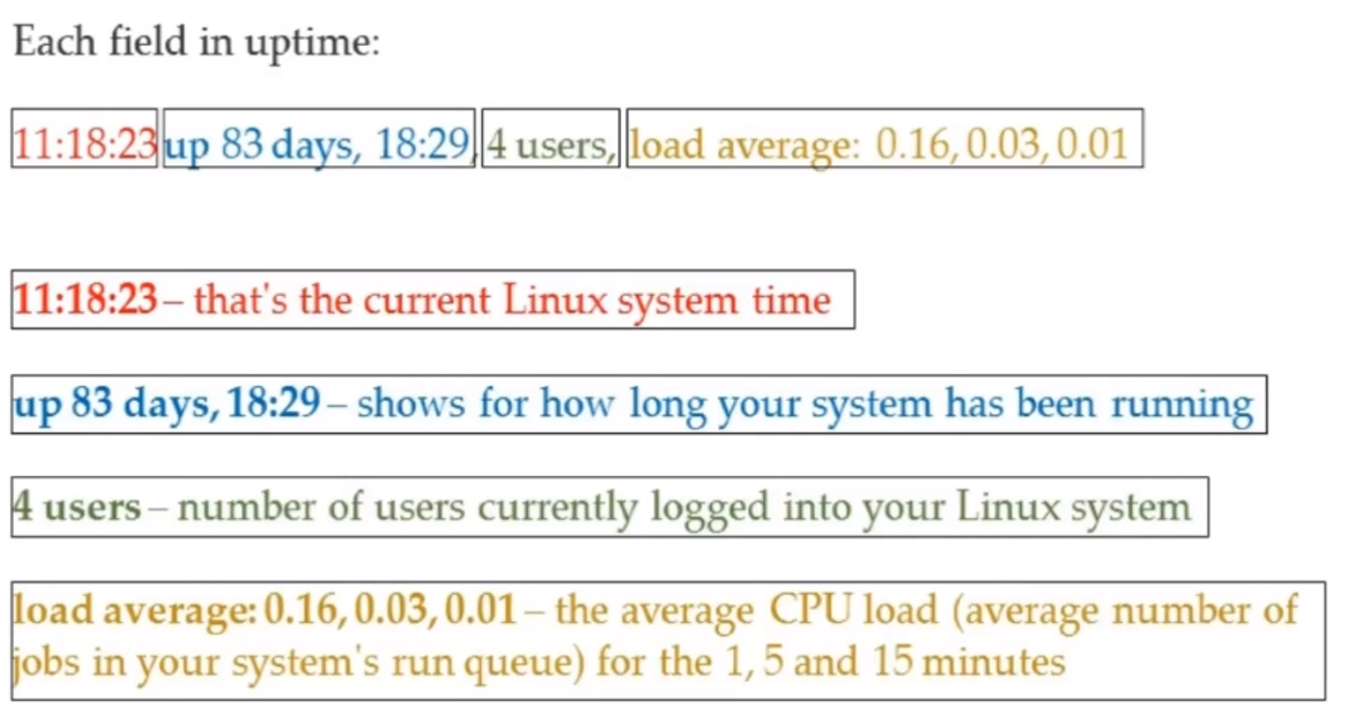
hostname: Displays or sets the system's hostname.uname/uname -a: Prints system information, including kernel version and system architecture.which: Determines the location of an executable file in the user's PATH.
which pwd
// it will give /usr/bin/pwd
cal- simply gives you a calendarbc- stands for binary calculator
Processes and Jobs
Applications = Service: Software programs designed to perform specific tasks, often provided as services to users or other programs.
Script: A sequence of executable commands, typically written in a scripting language, used to automate tasks.
Process: A running instance of a program in execution on a computer system.
Daemon: A background process that continuously runs and performs system-related tasks or provides services, such as network services.
Threads: Lightweight processes within a program that share the same memory space and resources, enabling concurrent execution.
Job: A unit of work or task scheduled or managed by an operating system or job scheduler.
Process/Service Commands
systemctl or service:
systemctl command is a new tool to control system services
It is available in version 7 and later and it replaces the service command
Usage example:
systemctl start | strop | status servicename.service (firewalld)
systemctl enable servicename.service
systemctl restart | reload servicename.service
systemctl list-units --all
The output has the following columns:
UNIT: The systemd unit name
LOAD: Whether the unit's configuration has been parsed by systemd. The configuration of loaded units is kept in memory.
ACTIVE: A summary state about whether the unit is active. This is usually a fairly basic way to tell if the unit has started successfully or not.
SUB: This is a lower-level state that indicates more detailed information about the unit. This often varies by unit type, state, and the actual method in which the unit runs.
DESCRIPTION: A short textual description of what the unit is/does.
To add a service under systemctl management:
create a unit file in
/etc/systemd/system/servicename.service
To control the system with systemctl
systemctl poweroff
systemctl halt
systemctl reboot
ps(process status) command
- It displays all the currently running processes in the Linux system
Usage example:
ps = shows the processes of the current shell
PID = the unique process ID
TTY = terminal type the user logged in
TIME = amount of CPU in minutes and seconds that the process has been running
CMD = name of the command
Other commands
ps -e = shows all running processes
ps aux = shows all running processes in BSD(Berkeley Software Distribution) format
ps -ef = shows all running processes in full format listing (most commonly used)
ps -u username = shows all processes by username
top command
used to show the Linux processes and it provides a real-time view of the running system.
This command shows the summary information of the system and the list of processes or threads which are currently managed by the Linux kernel
when the top command is executed then it goes into interactive mode and you can exit by hitting q.
Usage: top
PID: Shows the task’s unique process id
USER: Username of the owner of the task.
PR: The “PR” field shows the scheduling priorities of the process from the perspective of the kernel
NI: Represents a nice value of the task. a negative nice value implies higher priority and a positive nice value means lower priority.
VIRT: Total virtual memory used by the task
RES: Memory consumed by the process in RAM
SHR: Represents the amount of shared memory used by a task
S: This field shows the process state in the single-letter form
%CPU: Represents the CPU usage
%MEM: Shows the memory usage of task
TIME+: CPU time, the same as ‘TIME’ but reflecting more granularity through hundredths of a second.
top -u username = shows taks/processes by user owned
top then press c = shows commands absolute path
top then press k = kill a process by PID within top session
top then M and P = To sort all linux running process by Memory usage
kill Command
kill command is used to terminate processes manually
It sends a signal which ultimately terminates or kills a particular process or group of processes
Usage:
kill [option] [PID]
OPTION = Signal name or signal number
PID = Process ID
kill -l = to get a list of all signal names or signal number
The most used signals are:
kill PID = kill a process wiht default signal
kill -1 = restart
kill -2 = interrupt from the keyboard just like Ctrl C
kill -9 = Forcefully kill the process
kill -15 = kill a process gracefully.
other commands:
killall
pkill
crontab command
- crontab command is used to schedule tasks
Usage:
crobtab -e = edit teh crontab
crontab -l = list the crontab entries
crontab -r = remove the crontab
crond = crontab daemon/service that manages scheduling
systemctl status crond = to manage the crond service

Create a crontab entry by scheduling a task:
crontab -e
schedule, echo "this is my first crontab entry" > crontab-entry
at command
at command is like crontab which allows you to schedule jobs but only once
When the command is run it will enter interactive mode and you can get out by pressing Ctrl D
Usage:
at HH:MM PM = Schedule a job
atq = lists the at entries
atrm # = remove at entry (the # here is the entry number what the job will have)
systemctl status atd = ro manage the atd service
Create an entry by scheduling a task:
at 4:45PM -> enter
echo "this is my first at entry" > at-entry
Ctrl D
Other commands:
at 2:34 AM 101621 = schedule a job to run on oct 16th, 2021 at 2:34am
at 4PM + 4 days = schedule a job at 4pm four days from now
at now + 5 hours = schedule a job to run five hours from now
at 8:00 AM Sun = schedule a job to 8am on coming sunday
at 10:00 AM next month = schdule a job to 10am next month
Additional Cron Jobs
By default, there are 4 different types of cron jobs
Hourly
Daily
Weekly
Monthly
All the above crons are setup in
/etc/cron.__(directory)The timing for each is set in
/etc/anacrontab -- except hourlyFor hourly
/etc/cron.d/0hourly.
Process management
Background = Ctrl -z, jobs, and bg
Foreground = fg
Run process even after exit = nohup process &
OR = nohup process > /dev/null 2>&1 &
kill a process by name = pkill
process priority = nice (e.g. nice -n 5 process)
- The niceness scale goes from -20 to 19. The lower the number more priority that task gets
Process monitoring = top
List process = ps .
System Monitoring
top: Displays real-time system process information.df: Shows disk space usage.dmesg: Prints kernel message buffer.iostat: Reports CPU and input/output statistics.netstat: Displays network connections.free: Shows memory usage.cat /proc/cpuinfo: Prints CPU information.cat /proc/meminfo: Displays memory-related information.
Log Monitoring
Another and most important way of system administration is to log monitor:
Log Directory = /var/log: Location of system log files.boot: Records system boot messages.chronyd = NTP: Manages network time synchronization (NTP).cron: Scheduler for running recurring tasks.maillog: Logs mail server activity.secure: Records security-related messages.messages: General system messages log.httpd: Apache HTTP Server log.
System Maintenance Commands
shutdown: Command used to safely power off or reboot the system.init 0-6: Runlevel commands for system state management (0: Halt, 6: Reboot).reboot: Command to restart the system.halt: Command to halt or power off the system.Changing System Hostname
Changing the system Hostname
hostnamectl set-hostname newhostnaeme
Version 7 = Edit /etc/hostname: Set the system's hostname in Unix-like operating systems by editing the
/etc/hostnamefile.Version 6 = Edit /etc/sysconfig/network: Configure network settings, including hostname, in Unix-like operating systems by editing the
/etc/sysconfig/networkfile.
Finding System Information
There are a few commands to do so:
cat /etc/redhat-release: Displays the version and release information of the Red Hat Enterprise Linux distribution.uname -a: Prints system information including kernel version, architecture, and other details.dmidecode: Retrieves hardware information from the system's Desktop Management Interface (DMI) table.
cat /etc/redhat-release
uname -a
dmidecode
System Architecture
- The main difference between a 32-bit and 64-bit CPU is the number of calculations per second they can perform.
| Aspect | 32-bit CPU | 64-bit CPU |
| Number of Bits | 32 | 64 |
| Calculation Speed | Slower | Faster |
| Multi-core Support | Yes | Yes |
| Memory Limitations | Limited to 4 GB RAM | Can address more |
| Software Compatibility | Limited | Extensive |
| Performance Benefits | Limited | Enhanced |
| OS Support | Supported | Supported |
| Upgrade Considerations | Software Compatibility | Software Compatibility |
To check the Architecture
- In Linux
arch
- In Windows
go to my computer -> properties
Terminal Control Kyes
- Several key combinations on your keyboard usually have a special effect on the terminal.
The most common control keys are listed below:
CTRL-u = erase everything you have typed on the command line
CTRL-c = stop/kill a command
CTRL-z = suspend a command
CTRL-d = exit from an interactive program (signal end of data).
Terminal Commands
clear = to clear your screen
exit = exit out of the shell, terminal or a user session
script = the script command stores terminal activities in a log file that can be named by a user, when a name is not provided by a user, the default file name, typescript is used
To create a script, that'll record everything that you do in the terminal
script logfile-activity.log
Recover Root Password
These will be the steps to do so:
Restart your computer
Edit grub
Change password
reboot
SOS Report
When you are really in trouble and need help
Collect and package diagnostic and support data
Package name sos-version
Command:
sosreport
// after entering this command further proceed with it
Environment Variables
An environment variable is a dynamic-named value that can affect how running processes behave on a computer. They are part of the environment in which a process runs.
Simply put, it's a set of defined rules and values to build an environment.
For example see this house, it has defined places:

To view all environment variable
printevn OR envTo view ONE environment variable
echo $SHELL OR echo $PATHTo set the environment variable
export TEST=1 echo $TESTTo set environment variables permanently
vi .bashrc TEST='123' export TESTTo set global environment variables permanently
vi /etc/profile OR /etc/bashrc TEST='123' export TEST
Special Permissions with setuid, setgid, and sticky bit
- All permissions on a file or directory are referred to as bits

There are 3 additional permissions in Linux
setuid: bit tells Linux to run a program with the effective user id of the owner instead of the executor: (e.g passwd command) → /etc/shadow
setgid: bit tells Linux to run a program with the effective group id of the owner instead of the executor: (e.g. locate or wall command)
- Please note: This is present for only files that have executable permissions
sticky bit: a bit set on files/directories that allows only the owner or root to delete those files.
Note: setuid and setgid are not actual commands
To assign special permissions at the user level
chmod u+s xyz.sh
- To assign special permissions at the group level
chmod g+s xyz.sh
- To assign special permission at the user or group level
chmod u-s xyz.sh
chmod g-s xyz.sh
- To find all executables in Linux with setuid and setgid permissions
find / -perm /6000 -type f
Please Note: These bits work on c programming executables not on bash shell scripts.
Sticky bit:
- It is assigned to the last bit of permissions
-rwx rwx rwt (so this t here is sticky bit)
why? : Because everyone, any user in the Linux system can write to this directory, but that user, even though that user has their write permissions, cannot delete that directory. This is a way to protect that directory from accidental deletion from the system.
example of /tmp directory
So with this blog our Linux learning end that doesn't mean there nothing to explore more, we have just get familiar with very important topic here but we can go for more if we want. Okay then I'll see you in next Computer Networking Blog 👋.
Subscribe to my newsletter
Read articles from Suraj directly inside your inbox. Subscribe to the newsletter, and don't miss out.
Written by

Suraj
Suraj
I'm a Developer from India with a passion for DevOps ♾️ and open-source 🧑🏻💻. I'm always striving for the best code quality and seamless workflows. Currently, I'm exploring AI/ML and blockchain technologies. Alongside coding, I write Technical blogs at Hashnode, Dev.to & Medium 📝. In my free time, I love traveling, reading books